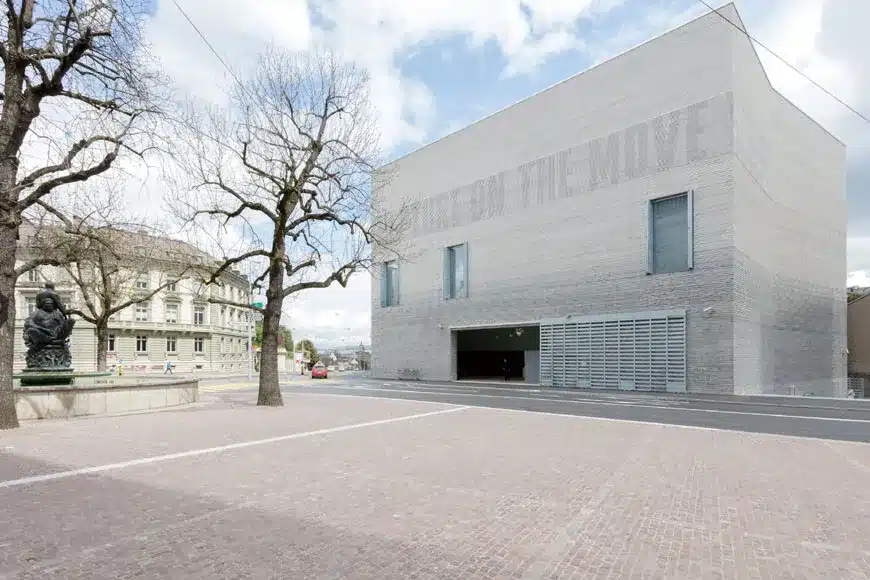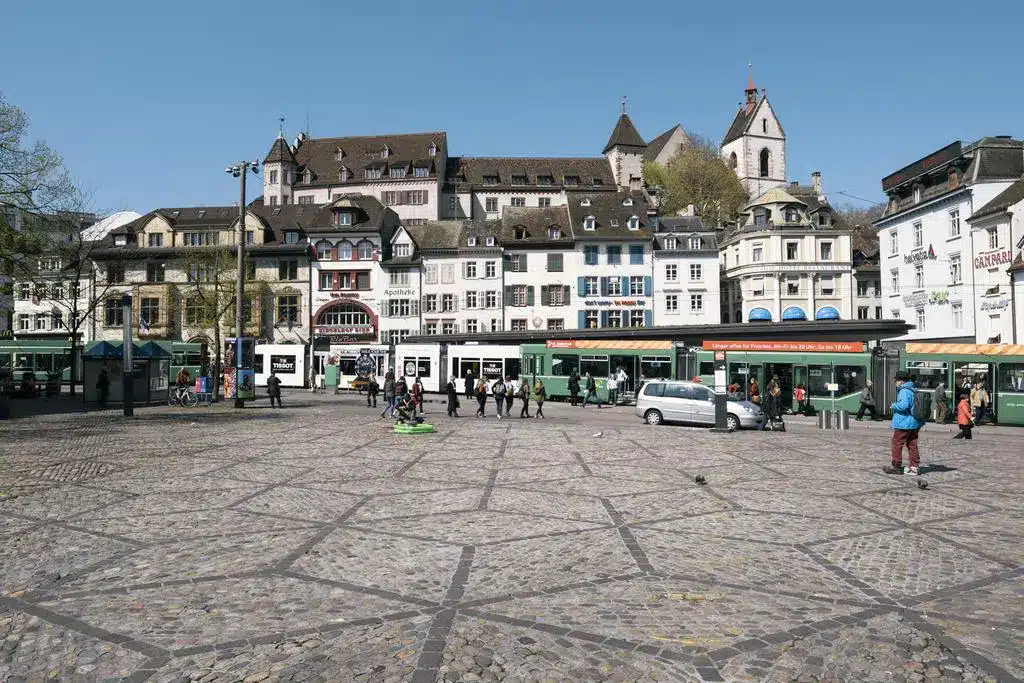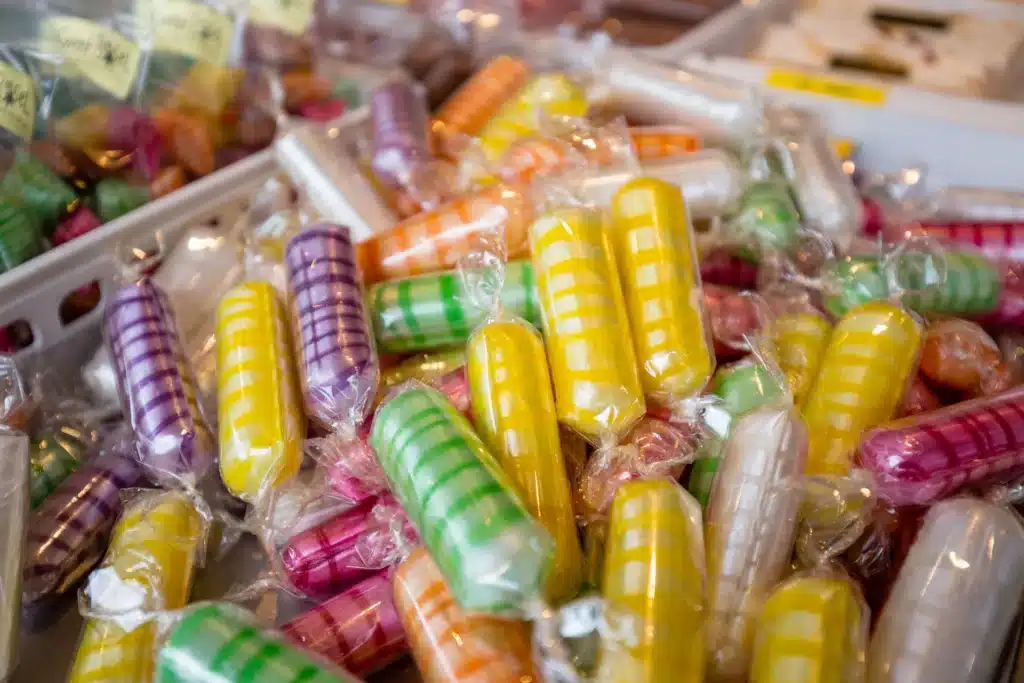16 Best Attractions in Basel offers a rundown of the top tourist attractions and things to do in Switzerland’s cultural capital.
Briefly about the cultural city of Basel..

Basel is a scenic city on the Rhine in northwestern Switzerland. It is close to the country’s borders with France and Germany.
Basel is a high importance city as the cultural capital of Switzerland. Its medieval old town centers around the Marktplatz, dominated by the red sandstone town hall from the 16th century. Basel’s 12th-century Gothic cathedral houses the mausoleum of the 16th-century Dutch scholar Erasmus. Erasmus’ works are housed in the city’s university. Due to its cultural attractions, the city of Basel has a competitive position among such cities in Europe.
Basel, Switzerland’s second largest city, has more than one museum per square kilometer. The total number of museums is more than 40. Also, many of these have artworks created by great architects like Renzo. Basel is famous for its many museums, including the Kunstmuseum, the world’s first public art collection (1661) and Switzerland’s largest art museum (the Fondation Bähler, located in Riehen).
After considerable periods of rule by the Austrian and German emperors, the city of Basel joined the Swiss Confederation in 1501. In the 16th century, the University of Basel became a center of humanism. The University of Basel was home to distinguished scholars and teachers. It may account for the outstanding cultural heritage of the city today.
01) Basel’s Old Town

Basel’s Altstadt (Old Town) is compact and easy to navigate, with many old buildings, bookshops, small galleries, arts and handicraft shops, and restaurants. It’s a pleasure to walk around the old, often cobbled streets, which provide a nice contrast to the otherwise sterile architecture of modern Basel.
The architectural diversity in Basel’s Old Town is unparalleled. The Mittlere Brücke building was built as far back as 1905, and its earliest construction dates back to 1220. The bridge provides an excellent view of the Basel skyline and the Basel Cathedral (Münster).
02) Basel Town Hall

The Rathaus (Basel City Hall) is worth seeing. The 500-year-old city hall has a beautiful inner courtyard, a romantic arcade and a tower. It dominates Basel’s Marktplatz. In particular, the cantonal parliament and the cantonal government of Basel-Stadt hold their meetings in the town hall.
After Basel joined the Swiss Confederation, the facade of the building was replaced with a new structure. The town hall was expanded in the early 17th century. Artist Hans Bock decorated the façade with trompe l’oeil paint. In 1900 the building was expanded again to include a left wing and a right wing tower.
03) Basel Minster (The Basler Münster)

The Basler Münster (Cathedral), along with the Mittlere Brücke, is probably Basel’s most well-known landmark. No other building in Basel adorns the cityscape like the Cathedral, with its red sandstone walls, colorful roof tiles, and twin towers. Basel Minster is an old religious building. It was originally a Catholic cathedral. It was later converted into a Reformed Protestant Church.
The original cathedral was built between 1019 and 1500 in Romanesque and Gothic styles. Located here, Rotterdam’s nave, chancel, Erasmus, Gallus Gate and two towers bear witness to a fascinating construction story spanning centuries. The cathedral piazza is now a popular meeting place and is frequently used for concerts and events. One of the most popular sights is the Pfalz, a terrace with stunning views of the Rhine.
04) The Kunstmuseum (Art Museum)

The Kunstmuseum Basel houses the world’s oldest public art collection and is widely regarded as the most important museum of art in Switzerland. It has been designated as a national heritage site. The museum’s focus is on paintings, drawings and graphic art by Upper Rhine region artists from 1400 to 1600, as well as art from the 19th to 21st centuries.
Northern Italian architecture influenced the design of the Basel Museum. Both historical structures, such as the Palazzo Ducale in Mantua, and contemporary architecture from the Novecento Italiano served as inspiration for its design. The main structure was created solely to house collections.
Its ancestors can be traced back to the Amerbach Cabinet, which was purchased by the city of Basel and the University of Basel in 1661, making it the world’s first municipally owned and thus open to the public museum. Its collection is distinguished by an impressively broad historical range, spanning the early 15th century to the present day. Its diverse areas of emphasis have earned it international recognition as one of the most significant museums of its kind.
05) Barfüsserplatz

Barfüsserplatz, a square of great antiquity, dates back to the year 1100. Barfüsserplatz square is located in the center of Basel, Switzerland. With eight tram lines crossing this square, it is the city’s most important and only tram station. Therefore, it is an important exchange point. Therefore, tourists and common people hang out here more.
Bafusserkirche at Barfüsserplatz

The Barfüsserkirche (formerly also the Franciscan Church) is located in the Swiss city of Basel, is a former monastery church and today houses the History Museum of the Basel Historical Museum. Centrally located in downtown Grossbasel, the church building dominates Barfüsserplatz.
06) Carnival Fountain

The fountain is in the square where the city theater used to be. In the shallow pool, ten mechanical sculptures with moving elements were placed and appear to be playing in the water as they move and spray water jets into the air. Jean Tinguely built the fountain in the 1970s.
Some popular attraction in the area (distance from the Carnival Fountain)
1) 340 m Basel Cathedral
2) Basel Art Museum – 270 m
3) Basel Art Museum – 270 m.
4) The Toy Worlds Museum is 120 meters away.
5) Basel-Stadt Town Hall is 530 meters away.
07) Zoo in Basel

Basel’s zoo, Switzerland’s oldest and largest, is affectionately known as the Zolli by locals and is one of the most popular tourist attractions in the country. It has been named one of the world’s top fifteen zoos.
Founded in 1874 with 510 European animals, the zoo is now better known for its exotic species. The population includes predators, primates, mammals, reptiles, birds, and aquatic life, and ranges from seahorses to elephants, the latter of which now enjoy a new elephant enclosure added in 2015, complete with wallowing pools, showers, and a savannah-like environment.
Highlights include the lion enclosure and monkey house, as well as the penguins in the vivarium, which also houses fish and reptiles. The aviary is home to both native and exotic birds, and also birds of prey. The zoo has had great success breeding rhinoceros and cheetahs.
08) Basel Paper Mill – Swiss Museum for Paper

This museum of writing, printing and paper is built on an old paper mill. Among the highlights here is the working water wheel set on a medieval canal, along with real working machinery. In this museum, visitors can see painstakingly handcrafted paper.
The evolution of printing can be explored through the 1980s with things used in typography (from before the Gutenberg press) to the demise of lead type. See how the books are bound as you tour the museum. The displays trace the evolution of writing from primitive sketches to modern typography.
09) Juedisches Museum Schweiz

One of the best Judaica collections in Central Europe depicts religious and everyday life while exploring the Jewish history of Basel and its surroundings. It not only documents local history, but it also introduces visitors to Jewish ceremonies and customs from around the world through exhibits on Jewish Law, the Jewish Year, everyday life, and history.
The courtyard contains medieval gravestones and documents dating back to the medieval Jewish communities, as well as documents printed in Hebrew by the city’s book printers between the 16th and 19th centuries. The two World Wars are the focus of significant documents.
10) Jean Tinguely Museum

The Museum Tinguely, located directly on the Rhine and designed by Ticinese architect Mario Botta, houses the largest collection of works by Jean Tinguely (1925-1991), one of the most innovative and important Swiss artists of the twentieth century.
Tinguely’s research spans four decades, as shown in the museum’s permanent exhibition. Special exhibitions feature a diverse range of artists and subjects, including Marcel Duchamp and Kurt Schwitters, Arman, Niki de Saint Phalle, and Yves Klein, as well as current art trends influenced by Tinguely’s ideas.
11) Rheinpromenade – An Observation Point

The view from the Kleinbasel bank to the cathedral in Basel, one of the four ferry piers, or a photograph of swimmers floating down the river? Which one will be your favorite picture? Outdoor bars, green spaces, pebble beaches, and Rhine swimming facilities are all available. There are numerous popular locations and photogenic motifs here. (Free entry)
12) City model Rheinpromenade – An Observation Point

This place is also an observation point where you can get beautiful photos. The city model on the Rhine’s Kleinbasel bank depicts a 1:500-scale section of the Old Town on the other side of the river, around the cathedral. The model’s various buildings and squares are also labeled in Braille. (Free Entry)
13) Haus zum Kirschgarten

The Haus zum Kirschgarten, one of Basel’s finest patrician houses, was constructed in the earliest Classical style between 1775 and 1780. It was the home and office of a prosperous Basel silk ribbon manufacturer and is now one of Switzerland’s best museums of domestic life.
Exhibits of the furniture of a wealthy 18th-century commercial family, together with internationally significant collections of decorative arts, can be found throughout the 25 furnished rooms. The porcelain collection of the Pauls-Eisenbeiss Foundation, a significant watch & clock collection, and major groups of Basel silver & scientific instruments are on display.
14) The Spalentor (A fortified gate)

The Spalentor, which dates from 1370, is a fortified gate that marks the end of the old town. Since the destruction of the old town walls in 1866, the town gate has stood alone. Look to the left of the gate for an early 19th-century letterbox with the Basel pigeon emblem.
The adjacent Peterskirche was rebuilt in the 15th century, but the vaulting in the choir dates from an earlier 14th-century structure. The Eberler chapel and the nave have frescoes. The university is nearby, and it has one of the world’s oldest botanical gardens, which was founded in the 16th century.
15) The Fondation Beyeler

The structure, designed by Genoese architect Renzo Piano, has been described as a “museological practicality.” The building is a wonderful contrast of solid concrete walls and light glass ceiling, drawing on the architect’s decades of experience in the world of museum design; it had been envisioned as a light-filled ‘greenhouse’ for art merging with the surrounding natural landscape and uplifted by the historical villa.
The structure is thoughtfully designed to give way to the art on display. The structure combines concrete and glass, with solid long walls topped by a light ‘floating’ glass roof designed to filter in diffused natural light.
The museum is composed of four equal-length main walls that run along the perimeter wall in a north-south direction, interspersed with cross sections of varying heights. The clean lines allow visitors to concentrate on the art. The white galleries themselves are minimalist, culminating in massive floor-to-ceiling windows that connect the insides with the outside. A long and narrow glass-encased winter garden runs along the western side.
16) Famous Traditional Food in Basel

Basel’s most well-known dishes include Basler flour soup, which is traditionally served during in the carnival (Fasnacht) with cheese and onion tart, as well as suuri Lääberli (sour, liver strips) & sweet Basler Leckerli, small, relatively hard gingerbread biscuits including a delicious sugar icing.

And Mässmogge is a brightly colored confection filled with a brown hazelnut mixture. They are about the size of a thumb. Mässmogge is a seasonal and regional specialty of Basel. They are popular among tourists. But they are also sold in other Swiss cities.
Recommended :

Leave a Reply
You must be logged in to post a comment.